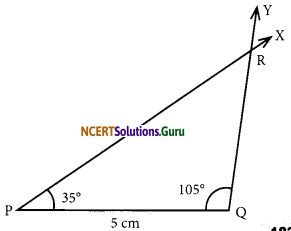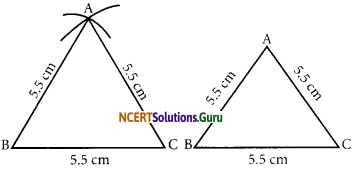These NCERT Solutions for Class 7 Maths Chapter 5 Lines and Angles Ex 5.2 Questions and Answers are prepared by our highly skilled subject experts.
NCERT Solutions for Class 7 Maths Chapter 5 Lines and Angles Exercise 5.2
Question 1.
State the property that is used in each of the following statements?
(i) If a || b, then ∠1 = ∠5.
(ii) If ∠4 = ∠6, then a || b.
(iii) If ∠4 + ∠5 = 180°, then a || b.

Answer:
(i) If two parallel lines are intersected by a transversal, then corresponding angles are equal.
(ii) If two given lines are intersected by a transversal such that alternate interior angles are equal, then the lines are parallel.
(iii) If two parallel lines are cut by a transversal such that the pairs of a interior angles on the same side of the transversal are supplementary, then the lines are parallel.
Question 2.
In the figure given below, identify
(i) the pairs of corresponding angles.
(ii) the pairs of alternate interior angles.
(iii) the pairs of interior angles on the same side of the transversal.
(iv) the vertically opposite angles.

Answer:
(i) The pairs of corresponding angles
are (∠1, ∠5); (∠2, ∠6); (∠3, ∠7); and (∠4, ∠8)
(ii) The pairs of alternate interior angles are (∠2, ∠8) and (∠3, ∠5)
(iii) The pairs of interior angles on the same side of the transversal are
(∠2, ∠5) and (∠3, ∠8)
(iv) The vertically opposite angles are (∠1, ∠3); (∠2, ∠4); (∠5, ∠7); and (∠6, ∠8)

Question 3.
In the figure given below, p || q. Find the unknown angles.
Answer:
Since, ∠e + 125° = 180°… (linear pair)
∠e = 180° – 125°
∠e = 55°
∠e = ∠f
(vertically opposite angles)
∴ ∠f = 55°
∴ ∠a = ∠e
(corresponding angles)
∠a = 55°
Again ∠b = 125°
(alternate exterior angles)
since, ∠b and ∠c form a linear pair
∴ ∠b+ ∠c= 180°
or 125° + ∠c = 180°
∠c = 180° – 125°
= 55°

Now, ∠b and ∠d are vertically opposite angles.
∴ ∠d = ∠b = 125°
[∵ ∠b = 125°]
Thus, the required measures are as follows: ∠a = 55°, ∠b = 125°, ∠c = 55°,∠d = 125°, ∠e = 55°, ∠f = 55°
Question 4.
Find the value of x in each of the following figures if 1 || m.

Answer:
(i) ∠x = ∠P
(alternate angles are equal)
But ∠P + 110° = 180° (linear pair)
∠P = 180°- 110°
= 70°
∴ ∠x = 70°
(ii) 1 and m are parallel and ‘a’ is a transversal.
∴ ∠x = 100°
(corresponding angles are equal)

Question 5.
In the given figure, the arms of two angles are parallel.
If ∠ABC = 70°, then find
(i) ∠DGC
(ii) ∠DEF

Answer:
We have AB || ED and BC || EF
(i) BC is a transversal
∴ ∠DGC – ∠ABC
(corresponding angles)
But∠ABC – 70°
∴ ∠DGC = 70°
(ii) ED is a transversal to BC || EF
∴ ∠DEF = ∠DGC
(corresponding angles)
But∠DGC = 70°
∴ ∠DEF = 70°

Question 6.
In the given figures below, decide whether 1 is parallel to m.

Answer:
(i) 44° + 126° = 170° ≠ 180°
Sum of the interior angles on the same side of the transversal is not 180°.
∴ 1 and m are not parallel.
(ii) n is a transversal to 1 and m and ∠P = 75°(vertically opposite angles)
also ∠P + 75°= 75° + 75° = 150° ≠ 180°
∴ 1 and m are not parallel as sum of interior angles on same side of transversal is not 180°.
(iii) ∠P + 123°= 180° (linear pair)
∠P = 180° – 123° = 57°
∠P = 57°(linear pair)
i.e., Corresponding angles are equal.
∴ 1 and m are parallel (corresponding angles are not equal)
(iv) ∠1 + ∠2 = 180°
∠1 + 98° = 180°
∠1 = 180°- 98°= 82°
∠3 = 72°
∠1 ≠∠3
∴1 and m are not parallel.

![]()


![]()



















